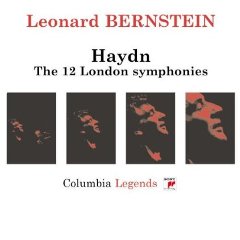Haydn - The 12 London Symphonies (Bernstein) CD5 [2003]
Haydn - The 12 London Symphonies (Bernstein) CD5 [2003]

Symphony in D major, Hob.I No.101 "The Clock" 1. Adagio-Presto 2. Andante 3. Menuet (Allegretto)-Trio 4. Finale (Vivace) Symphony in E flat major, Hob.I No.103 "Drum-Roll" 5. Adagio-Allegro con spirito-Tempo I 6. Andante piu tosto allegretto 7. Menuetto-Trio 8. Finale (Allegro con spirito) New York Philharmonic Leonard Bernstein – conductor
No 101, completed after the ‘Military’ but premiered four weeks earlier, on 3 March, also contains a ‘characteristic’ slow movement calculated to make an instant appeal to Haydn’s London audiences. Typically, though, the Andante’s tick-tock accompaniment generates an awesome power in the G minor central episode, reinforced at the climax by battering horns and trumpets. When G major tranquillity returns, Haydn cunningly reassigns the pendulum’s ticking to flute and bassoon, above and below the violin melody, and then, after a bar’s rest, dips to the unscripted key of E flat major, an effect both poetic and amusing. ‘Nothing can be more original than the subject of the first movement’, enthused the Morning Chronicle after No 101’s premiere; ‘and having found a happy subject, no man knows like HAYDN how to produce incessant variety without once departing from it.’ As usual in the ‘London’ symphonies, the motivic seeds are sown in the slow introduction, which prefigures the 6/8 Presto’s ‘happy’ (and teasingly irregular) subject in D minor. Again, though, it is the second subject—a playful, sinuous tune, closely akin to the first—that controls the plot, both in the development and in another of Haydn’s gloriously unpredictable, expanding recapitulations. Such is the symphonic weight and grandeur of the minuet, the longest in a Haydn symphony, that it comes as a surprise to learn that it was adapted from a minuet he had composed for mechanical organ. The trio’s pointedly naïve flute solo is accompanied by a notorious ‘wrong harmony’ joke which the strings then rectify on the repeat. Nineteenth-century editors with a musical humour bypass thought the joke must be a misprint and duly ‘corrected’ it. Opening with a mellow, songful theme, the finale is a sonata rondo at once intensely concentrated (much of the action is fuelled by its first three notes) and exhilaratingly free in design. After a ferocious ‘developing’ episode in D minor, the key of the symphony’s slow introduction, the recapitulation takes the form of a shimmering pianissimo fugato that Mendelssohn surely remembered in his Octet. ---Richard Wigmore, hyperion-records.co.uk
‘The introduction excited deepest attention’, wrote the Morning Chronicle after No 103’s premiere on 2 March. With its initial timpani roll and its sepulchral theme on cellos, basses and bassoons (shades here of the Dies irae chant), this is the most mysterious, portentous symphonic opening before Schubert’s ‘Unfinished’ and Beethoven’s Ninth. Haydn then proceeds to integrate the introduction systematically into the 6/8 Allegro con spirito. A fragment of the Dies irae theme flits by, transmuted into a blithe dance, just before the Ländler-ish second subject. At the heart of the development, after a grand pause, it makes a more theatrical appearance in its original deep bass register, like a spectre at the feast. Then, near the end of the movement, a series of apocalyptic orchestral crashes heralds another dramatic pause and a return of the introduction, complete with drumroll, in its original Adagio tempo. This is finally banished by the Dies irae theme in its dance transformation: at once a gleeful parody and a reinforcement of the symbiotic link between introduction and Allegro.
For his not-so-slow movement (Andante più tosto Allegretto) Haydn writes a set of ‘double’ variations on two related tunes, one in C minor, the other in C major, and both derived from Croatian folk melodies. Haydn gave the C major tune a more exotic gypsy flavour by raising its F naturals to F sharps, in the process aligning it more closely with the C minor tune. After the second major-keyed variation, beginning as delectable ‘toy soldier’ music and ending as an imperious march, a nostalgic reminiscence of the C major theme suggests a final envoi. Haydn, though, suddenly veers into E flat—the main key of the symphony—for a dramatic, modulating coda.
The swaggering minuet exploits and transfigures a traditional Austrian yodel, while the trio features graceful arabesques for clarinets, doubled by the strings (mindful, perhaps, of the limitations of his London players, Haydn tends to use the clarinets cautiously in these symphonies). Like the last movement of Mozart’s ‘Jupiter’, the finale is designed as a true symphonic apotheosis. In a compositional feat extraordinary even by his standards, Haydn creates a movement of thrilling harmonic and contrapuntal drama from the bare minimum of material: merely a traditional horn call and a snatch of Croatian folksong. ---Richard Wigmore, hyperion-records.co.uk
download (mp3 @320 kbs):
yandex 4shared mega mediafire zalivalka cloudmailru uplea








